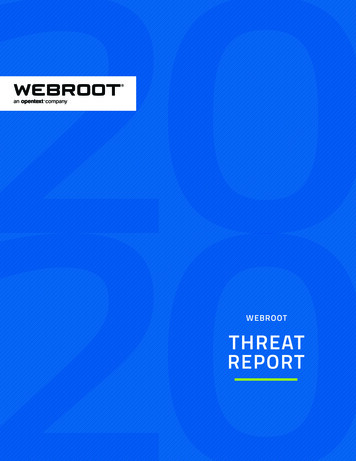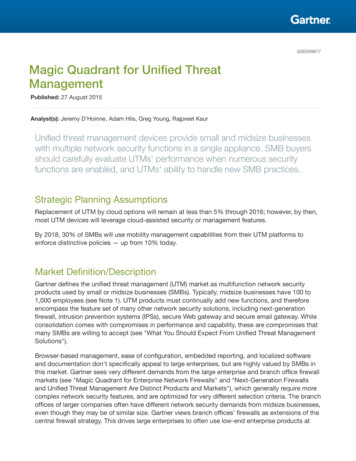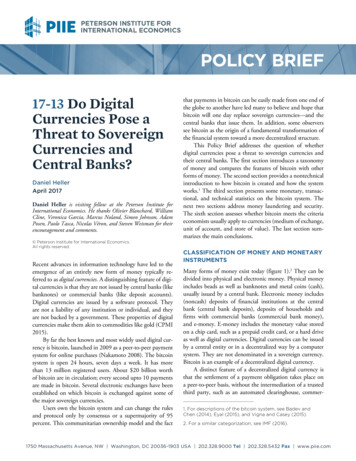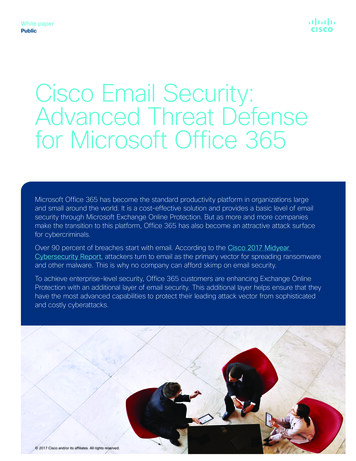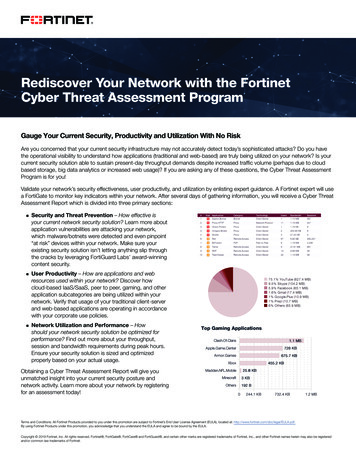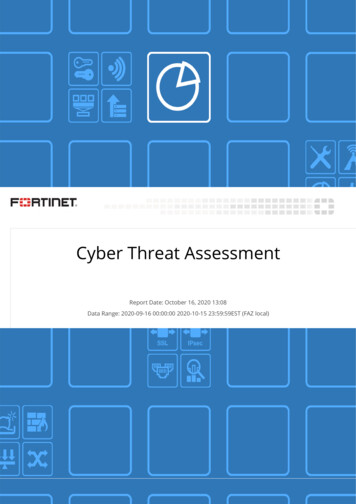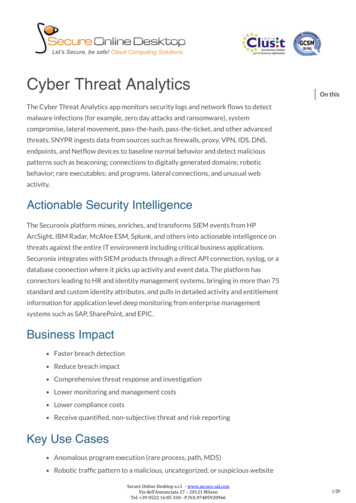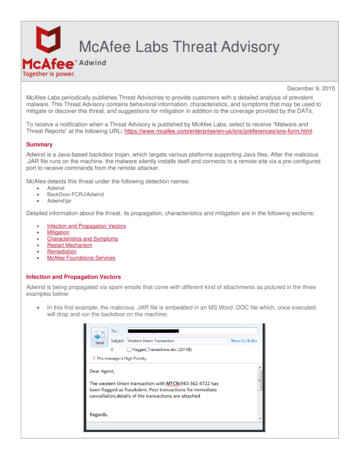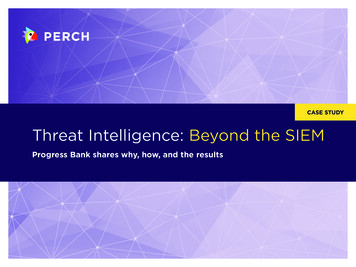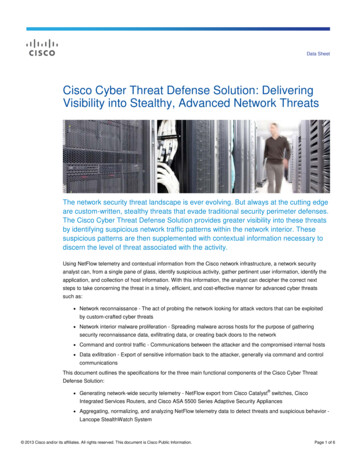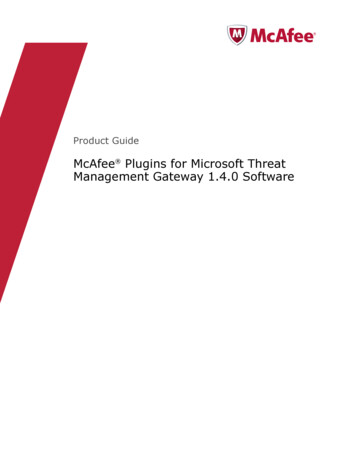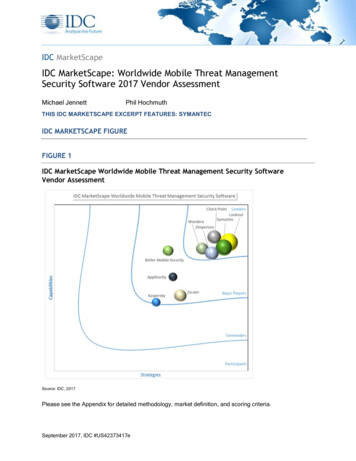
Transcription
THREATMONITORING, DETECTION & RESPONSE2017 REPORT
TABLE OF CONTENTSTHREAT MONITORINGDETECTION & RESPONSE2017 REPORTINTRODUCTION3KEY SURVEY FINDINGS4OVERVIEWConfidence in security postureCyber threats of concernTop security challengesOrganizational barriersSecurity business impactCyber attack outlookCapacity to detect threatsSources of monitoring data5678910111213THREAT MANAGEMENTThreat management responseThreat management prioritiesRansomwareThreat management platformsAspects of threat managementThreat management capabilitiesCyber attack recoveryThreat management budget141516171819202122THREAT INTELLIGENCEThreat intelligence measuresUsers of threat intelligenceThreat intelligence impactPrioritization of security events2324252627INSIDER THREATInsider threat confidenceNature of insider threatsGrowth of insider threatsCombating insider threatsRisky usersInternal vs external attacksSpeed of recovery2829303132333435METHODOLOGY & DEMOGRAPHICS36SPONSORS OVERVIEW38CONTACT US45
INTRODUCTIONInformation security teams worldwideare increasingly concerned about therapid growth of cyber threats. To addressthis concern and provide peer insights,Crowd Research Partners, in partnershipwith the 370,000 member InformationSecurity Community on LinkedIn, hasconducted an in-depth study on severalWe believe that the insights from this report willprovide valuable guidance on effectively identifyingand addressing a range of cyber threats.We would like to thank our study sponsors forsupporting this research on a critical topic withinthe information security community: AlienVault Bitglass BluVector ControlScan Delta Risk DomainTools Dtex EventTracker Exabeam ObserveIT SoftActivity Tenableimportant threat lifecycle topics.This study is a summary of responsesfrom over 400 cybersecurity professionalsto provide a comprehensive snapshot onthe evolving threat landscape, insider andexternal threats, preventative measures,threat monitoring and data collection,threat intelligence, threat detection,threat hunting, threat analytics, incidentresponse, and incident recovery.In addition, we want to thank all survey participantswho provided their time and input in completingthe study.We hope you will enjoy reading this report and gaininsight from its major findings.Thank you,Holger SchulzeHolger SchulzeFounderLinkedin InformationSecurity Communityhhschulze@gmail.comTHREAT MONITORING, DETECTION & RESPONSE REPORTGroup PartnerInformationSecurity3
KEY FINDINGS1Dealing with advanced threats is the most significant concern for cybersecurity professionals:ransomware (48%), phishing attacks (48%) and attendant data loss (47%). The level of concern withthese threat categories has grown significantly over the past 6 months.2Respondents noted significant challenges in responding to advanced threats - the most significantbeing the ability to detect threats (62%). Interestingly, survey participants also noted concerns withthe lack of advanced security staff (41%) and slow speed of response (23%).3As with prior surveys, lack of budget (51%), lack of skilled personnel (49%), and lack of security4A large proportion of organizations use threat intelligence platforms – with 57% using one or more5Insider threats continue to be a growing concern (51% perceived a growth in these threats overawareness (49%) weighed in as the most significant obstacles facing security teams.commercial threat intelligence providers followed by 47% using open source platforms.the past year) with inadvertent breaches (61%) identified as the leading cause. User training wasidentified by 57% of respondents as their leading method for combating such threats.THREAT MONITORING, DETECTION & RESPONSE REPORT4
OVERVIEW
CONFIDENCE IN SECURITY POSTUREFor each of our surveys, we like to gain a perspective on organizations’ overall confidence in their security posture. Whencomparing survey results to a prior survey conducted in January of 2017, we found that responses for the moderately toextremely confident categories declined by a collective 5 percentage points. This may be due to concerns following the recentspate of ransomware attacks.Q: How confident are you in your organization’s overall security posture?Moderately confident42%Slightlyconfident16%Not at all confident5%THREAT MONITORING, DETECTION & RESPONSE REPORTVeryconfident28%9%Extremelyconfident6
CYBER THREATS OF CONCERNWe asked respondents to identify the areas of cyberthreats most concerning to them. Not surprisingly, given the recent spate ofransomware attacks, this is a top area of concern (at 48%). Interestingly, phishing attacks and the attendant impact of data losswere also at about the same level of concern (48% and 47% respectively).Security teams’ concerns are evolving with the rapidly changing nature of cyberthreats. In comparing the results of this study toour Cybersecurity Trends report created earlier this year, we saw a marked growth in the level of concern with phishing attacksand malware – as well as significant new areas of concern with ransomware and attendant data loss. We also noted a similargrowing concern with insider threats, even though the threat has a different underlying root cause.Q: Which cyberthreats are you most concerned about?48%48%Phishing attacksRansomware47%Data exfiltration/data loss43%43%38%37%37%Insider attacksMalwareUnauthorizedAccessAdvanced persistentthreats (APTs)/targeted attacksZero-dayattacksHijacking of accounts, services or resources 36% Web application attacks (buffer overflows, SQL injections, cross-site scripting) 28% Denial of service attacks (DoS/DDoS) 26%THREAT MONITORING, DETECTION & RESPONSE REPORT7
TOP SECURITY CHALLENGESGiven the cyberthreats of concern, we investigated how they related to the challenges faced by security teams. Here, we notedan interesting pattern of challenges related to the current generation of threats – their detection (62%), lack of advanced securitystaff (41%), and slow response times to remediate (23%). These challenges are consistent in the cybersecurity industry and wereidentified in other areas of this report.Q: Which of the following do you consider to be top challenges facing your security team?62%48%Detection and/ormitigation of insiderthreats (negligent,malicious, andcompromised users)Detection ofadvanced threats(hidden, unknown,and emerging)41%41%27%25%24%The lack of advancedsecurity staff tooversee threatmanagementGetting full visibilityto all assets andvulnerabilities acrossthe entire environmentLack of confidencein automation toolscatching all threatsLack of properreporting toolsMonitoring securityof cloud infrastructureSlow response time to advanced threats 23% Too much time wasted on false positive alerts 20% Working with outdated SIEM tools and SOC infrastructure 19% THREAT MONITORING, DETECTION & RESPONSE REPORT8
ORGANIZATIONAL BARRIERSGiven the challenges faced by security teams, we wanted to understand the key organizational barriers preventing teams fromeffectively responding to cyberthreats. Consistent with our prior research, budget (51%), lack of skilled personnel (49%), and lackof security awareness (49%) were reported as the key inhibitors by half of the respondents.Q: Which of the following barriers inhibit your organization from adequately defending against cyberthreats?#1#2#3Lack of budgetLack of skilled/trained personnel49%51%31%30%Poor integration/interoperability betweensecurity solutionsToo much datato analyze28%Lack of managementsupport/awareness/buy-in#4Lack of security awarenessamong employeesInsufficient or inadequatetools available in house49%36%28%25%23%Lack of visibility intonetwork traffic andother processesLack of collaborationbetween separatedepartmentsInability to justifyadditional investmentLack of contextual information from security tools 23% Difficulty in implementing new security systems/tools 21% Too many false positives 20% Lack of confidence inusing the information to make decisions 15% Lack of effective security solutions available in the market 14%THREAT MONITORING, DETECTION & RESPONSE REPORT9
SECURITY BUSINESS IMPACTWhen asked about the business impact of security incidents, system downtime was highlighted as having the biggest impact –as might be expected. Several significant consequences included disruption of business operations, reduced productivity, andthe need to redeploy IT resources. Interestingly, revenue impact was only cited as a relatively minor factor – suggesting thateither security teams have evolved their maturity to effectively manage risk or lack full visibility into the downstream businessimpact of security incidents.Q: What negative impact did your business experience from security incidents in the past 12 months?38%Systemdowntime33%Disrupted businessactivities33%Reduced employeeproductivity33%Deployment of ITresources to triageand remediate issueNo business impact 29% Increased helpdesk time 26% Data loss 24% Reduced revenue/lost business 16% Negative publicity/reputational damage 13% Loss/compromise of intellectual property 11% Customer loss 8% Lawsuit/legal issues 6% Regulatory fines 5%THREAT MONITORING, DETECTION & RESPONSE REPORT10
CYBER ATTACK OUTLOOKOne of the points we investigated was to understand how sanguine security teams were in their assessment of exposureto future attacks. Here, we found a remarkably even distribution of expectations. Roughly a third (32%) expected thatcompromise was more likely, while a slightly smaller number (29%) felt that compromise was less likely. We suggest thatthis is a reflection of confidence in security posture – with the 51% of “Less Likely” and “No Change” respondents havingvarying degrees of confidence.Q: What is the likelihood that your organization will become compromised by a successful cyber attack in the next 12 months,compared to last year?32%Not sure17%No changeMore likely22%29%Less likelyTHREAT MONITORING, DETECTION & RESPONSE REPORT11
CAPACITY TO DETECT THREATSThreat detection competence is a major factor in organizations’ capacity to manage their cyber risk. Here, we saw an interestingpattern of over 83% indicating that they were average or above average. We’re not sure of the reasons for this uneven distribution– particularly given a much more balanced response to expectations of compromise to cyber attack.Q: How do you assess your organization’s current ability to DETECT threats?Superior, ascompared to peers7%36%Above average40%AverageBelow averageDeficientTHREAT MONITORING, DETECTION & RESPONSE REPORT6%11%12
SOURCES OF MONITORING DATANot surprisingly, the most common sources of monitoring data are applications, firewalls, and endpoints. However, as evidentfrom the survey results, there is a “long tail effect” with data collection from a broad range of sources.Q: What systems, services and applications do you collect monitoring data from?59%57%Applications(event logs, audit logs)54%Vulnerabilitymanagement toolsNetwork-based firewalls(IPS/IDS/UTM devices)52%41%Host-basedanti-malwareNetwork packet-baseddetection57%Endpoint(PC, laptop, mobile device,MDM, NAC, log collectors,anti-malware tools)40%Intelligence fromyour security vendors39%Host-basedIPS/IDSSecurity intelligence feeds from third-party services 37% User and Entity Behavior Analytics (UEBA) 35% Whois/DNS/Dig and other Internet lookup tools 34% SIEMtechnologies and systems 33% Relational Databases (transactions, event logs, audit logs) 32% Dedicated log management platform 31% ID/IAM (identity and accessmanagement) systems 29% Network-based malware sandbox platforms 29% Cloud activity 24% Netflow 22% Social media applications (Facebook, Twitter) 19% Terminal servers 19% Management systems for unstructured data sources (NoSQL, Hadoop) 13%THREAT MONITORING, DETECTION & RESPONSE REPORT13
THREAT MANAGEMENTTHREAT MONITORING, DETECTION & RESPONSE REPORT14
THREAT MANAGEMENT RESPONSEOne of the interesting questions with security teams is their criteria for judging their competence. In looking at self-assessment ofcompetence in ability to detect threats we found it was very strongly related to the time to detect and respond to incidents.The data was striking in looking at the gap between 4 hour response and 1 day response. Close to 60% of companiesconsidering themselves as superior had sub 4 hour response, whereas 75% of companies self-declaring as deficient had responsetime as greater than 1 day.Q: On average how long does it take you to detect, validate and respond to suspected incidents in your organization?32%0-4 hours24%5-12 hoursTHREAT MONITORING, DETECTION & RESPONSE REPORT14%19%3%13-23 hours1-7 days8-14 days8%more than 14 days15
THREAT MANAGEMENT PRIORITIESIn the focus area of threat management, survey participants were asked about their top priorities. Not surprisingly, improvedthreat detection was the most significant priority – at 67% – by a large margin above improved investigation and analysis ofthreats at 44%.Q: What are the most critical threat management priorities for your organization over the next 12 months?67%Improve threatdetection44%Improve investigatingand analyzing threats43%Proactivethreat hunting41%Improve blockingthreats38%Reduce unwanted /unauthorized traffic36%Automateincident responseImprove lateral movement detection 32% Aggregate security alerts 30% Improve enforcement of usage policies 29% Reduce false positive alerts 25% Not sure 9%THREAT MONITORING, DETECTION & RESPONSE REPORT16
RANSOMWAREWith the recent ransomware attacks making front-page headlines, we asked respondents about their preferred security solutionsto combat this threat category. While organizations employed multiple methods of protection, anti-malware was the dominantpreferred method (as expected) – at 76%. Interestingly, data backup and recovery was the second choice – at 65%.Q: What security solutions do you currently employ to combat ransomware?Anti Malware76%58%Email andweb gateways56%Userawareness39%Advancedendpoint securityTHREAT MONITORING, DETECTION & RESPONSE REPORTOperating systemsand software are currentwith latest patchesData backupand yanalytics27%User and EntityBehavior Analytics(UEBA)17
THREAT MANAGEMENT PLATFORMSSecurity teams use a broad range of threat management platforms, products and services. Endpoint security is the most common(62%) with IDS/IPS/UTM/Firewalls a close second at 55%. Beyond this we see a “long tail” of platforms ranging from vulnerabilitymanagement and log management to commercial threat intelligence.Q: Please indicate which type of threat management platform(s) you use, if any.62%55%39%Endpointsecurity vendorIDS/IPS/UTM/Firewall vendorVulnerabilitymanagement vendor37%Log managementvendor34%Identity and AccessManagement(IAM) vendor32%SIEMvendor31%31%25%User and EntityBehavior Analytics(UEBA)Application securityvendor (includingwhitelisting/blacklisting)Managed securityservices providerNetwork packet broker/ Inline monitoring vendor 16% Forensics vendor 16% “Dark web” monitoring vendor 12% CTI service provider 10% Deception-baseddetection vendor 9% CTI platform provider 8%THREAT MONITORING, DETECTION & RESPONSE REPORT18
ASPECTS OF THREAT MANAGEMENTAmong our respondents, the primary pattern of threat management appeared to be one of “blocking” (deterrence at 67%and denial at 66%). Post event activities – detection (56%) and incident response (54%) – were not as commonly utilized.This reflects what we have seen as the most common security posture – defend first, but be prepared to respond toanything that gets through.Q: What aspect(s) of threat management does your organization mostly focus on?67%Deterrence(e.g., access controls,encryption, policies, etc.)66%Denial(e.g., firewall)39%Analysis & Post Breach Forensics(e.g., SIEM, log analysis, etc.)56%Detection(e.g., user monitoring,IDS, UEBA, etc.)54%IncidentResponse23%17%4%Disruption& MitigationDeception(e.g., honeypots, etc.)NoneTHREAT MONITORING, DETECTION & RESPONSE REPORT19
THREAT MANAGEMENT CAPABILITIESWhat threat management capabilities do cybersecurity professionals prioritize? The capacity to rapidly identify and remediateattacks leads with 76 percent, followed by 24x7 threat intelligence, monitoring and analytics (72%), and threat reporting toidentify vulnerabilities (68%).Q: How valuable are the following features/capabilities?76%Rapid identification andremediation of attacks72%68%58%24x7 threat intelligence,monitoring and analysisThreat assessmentreports to identifyvulnerabilities and risksSecurity policy andcontrols managementEasy incident investigation 57% Compliance oriented activities 34%THREAT MONITORING, DETECTION & RESPONSE REPORT20
CYBER ATTACK RECOVERYWhile 29 percent of organizations recover from cybersecurity attacks within minutes or hours, 36 percent take from a day up to aweek to recover.Q: How long does it take your organization to recover from a cyber attack (on average)?29%8%Within minutesrecover from attackswithin minutes or hours21%Within hours17%19%Within one dayWithin one week36%THREAT MONITORING, DETECTION & RESPONSE REPORT8%Within one monthtake between one dayand one week to recover1%Within threemonths2%Longer thanthree monthsNo ability to recover 1%Not sure 23%21
THREAT MANAGEMENT BUDGETBudgets for threat management are expected to increase for over a third of organizations (36%) in the next 12 months.Q: How is your threat management budget changing in the next 12 months?54%Budget36%will stayunchangedBudget willincrease10%Budgetwill declineTHREAT MONITORING, DETECTION & RESPONSE REPORT22
THREAT INTELLIGENCETHREAT MONITORING, DETECTION & RESPONSE REPORT23
THREAT INTELLIGENCE MEASURESAs reported by survey participants, commercial threat intelligence is the most commonly used (57% use one or more commercialproviders), with a second group using open source platforms (47%). Interestingly – and most surprising – roughly a fifth ofrespondents (21%) indicated that they did not use any threat intelligence.Q: What threat intelligence measures do you use?We use one or morecommercial providersof threat intelligence57%We use open sourcethreat intelligence47%We haveno threatintelligence17% 21%We use multiple commercialproviders of threat intelligence;also lay traps to developour own learningsTHREAT MONITORING, DETECTION & RESPONSE REPORT24
USERS OF THREAT INTELLIGENCEOur survey investigated the uses of threat intelligence. As would be expected, the IT security team is the primary consumer(70%), with the incident response and SOC teams being significant consumers of data (43% and 38% respectively). What isinteresting is the breadth of usage – extending to executive management and legal.Q: Who are the primary consumers of threat intelligence in your organization?70%IT security team43%Incident response team38%Security operations center (SOC)28%Automated threat intelligenceExecutive leadership(Board of Directors, C-level staff)25%23%Insider threat teamRisk and compliance groups21%Middle management, business owners21%13%Legal departmentWorkforce in general10%THREAT MONITORING, DETECTION & RESPONSE REPORT25
THREAT INTELLIGENCE IMPACTOne of our most significant areas of investigation was to identify the benefits of the use of threat intelligence. As we found, abouthalf (49%) of respondents reported a reduction in breaches – although to varying degrees.Q: Has the occurrence of security breaches changed as a result of using threat intelligence solutions?17%Significant reductionin breaches32%Some reductionin breaches34%Not sure17%No Improvementt and move the following slices to the top: 17% “Significant reduction in breaches” and 32% “Some reduction in breaches”.THREAT MONITORING, DETECTION & RESPONSE REPORT26
PRIORITIZATION OF SECURITY EVENTSIn threat management, an important question is how security events are brought to t
the evolving threat landscape, insider and external threats, preventative measures, threat monitoring and data collection, threat intelligence, threat detection, threat hunting, threat analytics, incident response, and incident recovery. 3 Holger Schulze Founder Li
